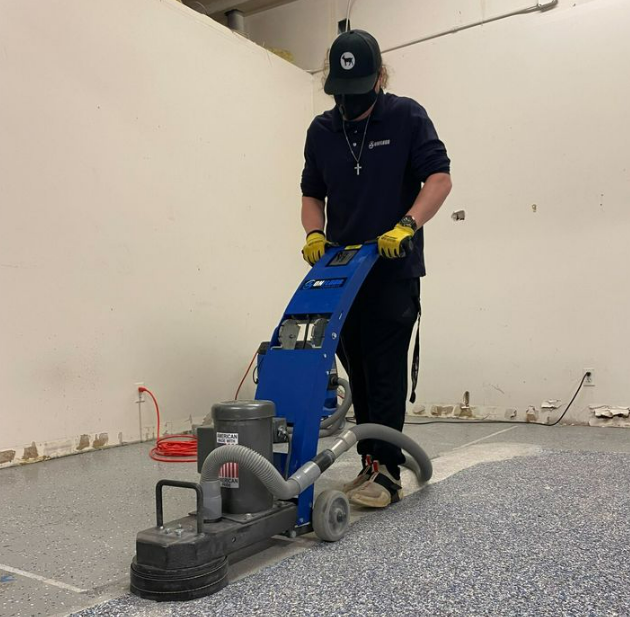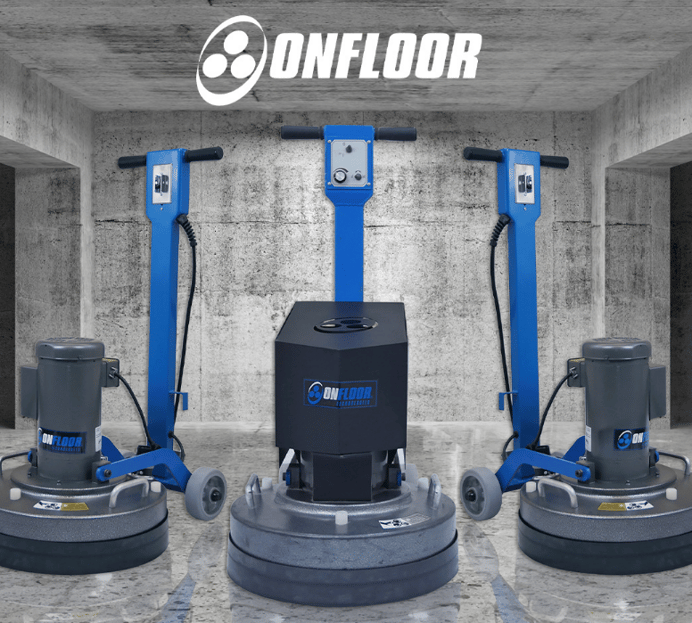If you're in the concrete industry, you know how important it is to have the right equipment for the job. One of the most essential tools you need is a walk-behind concrete grinder.
Not only does it help you achieve a smooth and professional finish, but it also saves time and money compared to renting one for each project.
But with so many options available on the market to grind concrete surfaces, it can be overwhelming to choose the right walk-behind concrete grinder. In this article, we will guide you through the features and considerations you need to make before purchasing one.
Types of Walk Behind Concrete Grinder
When it comes to grinding concrete, there are three main types of walk-behind concrete grinders: small, medium, and large.
- Small Concrete Grinders: These are best suited for minor repairs and small projects. They are smaller in size and lighter in weight, making them easy to carry and maneuver. However, they may lack the power needed for larger projects.
- Medium Concrete Grinders: These are suitable for general grinding and polishing tasks. They have a higher power output and can cover a larger surface area, making them ideal for medium-sized projects.
- Large Concrete Grinders: These are heavy-duty concrete grinders designed for large-scale commercial or industrial projects. They have the most powerful motors and can cover a significant amount of surface area in a short period. However, they are heavier and may require more than one person to operate.
- Quick Change Tooling Grinders: Exclusively available with Onfloor, these grinders can accommodate up to 30 different tool options for various flooring applications. This unique system is touted as the fastest tool change in the industry.
Considerations Before Purchasing
Power Source
Before purchasing a walk-behind concrete grinder, it's essential to consider the power source available at your job site. Some models are electric-powered, while others run on gas.
Electric concrete grinders are more suitable for indoor projects as they do not produce fumes or emissions. They are also quieter and have a lower carbon footprint.
On the other hand, gas-powered concrete grinding machines offer more mobility and can be used in all weather conditions. However, they tend to be heavier and noisier than electric models.
Surface Compatibility
Another key consideration is the type of surface you will be grinding. While most walk-behind concrete grinders can handle various surfaces, some may not be compatible with certain types of concrete, such as "wet set" cement.
It's essential to choose a concrete grinder that is suitable for the type of projects you typically work on to avoid any limitations or difficulties during use.
Ergonomics
Grinding concrete is a physically demanding task, so it's essential to consider the ergonomics of the concrete grinder before purchasing. Consider factors such as weight, handle placement, and vibration levels.
It's crucial to choose a walk-behind concrete grinder that is comfortable for you or your workers to operate for extended periods without causing strain or fatigue. With over 20 years in the industry, every Onfloor machine is made with expert knowledge of ergonomics and efficiency in mind.
Maintenance
Like any other equipment, walk-behind concrete grinders require regular maintenance to function correctly and last longer. Gas-powered models may need more attention due to their engines, while electric ones may only require occasional blade sharpening or replacement.
Be sure to factor in the cost and frequency of maintenance for each model before making your final decision.
Grinding Depth
Consider the maximum grinding depth of each model and choose one that can handle your project's requirements. Some concrete grinders may have adjustable settings, allowing for more versatility.
Price
While it may be tempting to go for a cheaper option, it's important to consider the long-term costs and benefits. When considering a concrete grinder, it is important to base your investment on the reliability, time, and maintenance required to maximize your investment.

Portability
If you frequently work on different job sites or have limited storage space, consider a more portable and compact walk-behind concrete grinder. Some models come with folding handles for easy transport.
When it comes to portability, Onfloor offers some of the most portable and versatile concrete grinding machines. Our single-speed machines are so light no trailer or special delivery is needed!
Additional Features
Look for additional features that may make the grinding process easier, such as adjustable handles, multiple speed settings, or vibration-dampening technology. These features can enhance productivity and efficiency, making the job more manageable.
Benefits of a Walk Behind Concrete Grinder
Ease of Use
One of the most significant advantages of a walk-behind concrete concrete grinder is its ease of use. Unlike handheld concrete grinders, they are less strenuous on the user and can cover larger surface areas in a shorter time.
Cost Savings
Investing in your own walk-behind concrete grinder can save you money in the long run compared to constantly renting one for each project. Moreover, gives you the ability to expand your service offerings. With Onfloor’s Quick Change tooling system, all you need is one machine to tackle a variety of jobs.
Versatility
Walk-behind concrete concrete grinders are versatile tools that can be used for a variety of tasks, including grinding, polishing, honing, and scarifying. With the right attachments, they can even remove adhesives or coatings from surfaces.
Safety Considerations
It's essential to prioritize safety when operating a walk-behind concrete concrete grinder. Here are some key safety considerations to keep in mind:
- Wear protective gear such as gloves, goggles, and earplugs to protect yourself from debris and noise.
- Make sure the concrete grinder is turned off and unplugged before changing blades or performing any maintenance.
- Always read and follow the manufacturer's instructions for safe operation.
- Keep bystanders at a safe distance from the grinding area.
- Check the concrete grinder and blades for any damage before each use.
- Make sure the work area is well-lit to avoid tripping hazards or accidents.
- Use proper lifting techniques when moving heavy concrete grinders to avoid strain or injury.
FAQs
How much does a walk-behind concrete concrete grinder cost?
The price of a walk-behind concrete grinder can vary depending on the size, power source, and additional features.
Can I use a walk-behind concrete concrete grinder for other surfaces besides concrete?
Yes, with the right attachments and settings, walk-behind concrete concrete grinders can be used on various surfaces such as stone, asphalt, and terrazzo.
Do I need any special training to operate a walk-behind concrete concrete grinder?
It's essential to have some basic knowledge of using power tools and safety precautions. It's also recommended to read the manufacturer's instructions before use and wear proper personal protective equipment (PPE).
How often does a walk-behind concrete concrete grinder require maintenance?
The frequency of maintenance can vary depending on the model and usage. However, it's recommended to regularly check and clean the blade, change the oil in gas-powered models, and inspect for any signs of wear or damage.

Can I use a walk-behind concrete concrete grinder for both wet and dry grinding?
Yes, some models come with adjustable settings that allow for both wet and dry grinding. However, it's crucial to check the manufacturer's specifications before using the concrete grinder for wet applications.
Do I need to use any special blades for a walk-behind concrete grinder?
Yes, it's essential to use diamond grinding blades specifically designed for the type of surface you are working on. Using the wrong blade can result in poor performance and damage to the concrete grinder.
How loud is a walk-behind concrete concrete grinder?
The noise level of a walk-behind concrete concrete grinder can vary depending on the model and power source. On average, gas-powered concrete grinders tend to be louder than electric ones, but wearing hearing protection is recommended for both.
What is the difference between a single-headed and dual-headed walk-behind concrete grinder?
A single-headed concrete grinder has one rotating disc, while a dual-headed concrete grinder has two discs that spin in opposite directions. Dual-headed concrete grinders are typically more powerful and can cover a larger surface area in less time.
Are walk-behind concrete concrete grinders safe to use?
Walk-behind concrete concrete grinders can be dangerous if not used properly. It's crucial to follow all safety precautions, wear proper PPE, and read the manufacturer's instructions before use.
Can a walk-behind concrete concrete grinder be used for leveling uneven concrete surfaces?
Yes, a walk-behind concrete concrete grinder can be used to level and smooth out uneven concrete surfaces. However, it's important to note that large bumps or holes may require additional repairs before grinding.
Do I need any experience to operate a walk-behind concrete concrete grinder?
While prior experience with power tools is helpful, it's not necessary to operate a walk-behind concrete concrete grinder. However, proper training and familiarization with the equipment is recommended before use.
All in All...
A walk-behind concrete grinder is a versatile and cost-effective tool that can save time, money, and effort on any concrete project. With proper safety precautions and maintenance, it can be a valuable addition to any contractor's toolkit.
Whether you're grinding, polishing, honing, or scarifying, a walk-behind concrete grinder is a reliable choice for achieving professional results. So, consider investing in one for your next concrete project and experience its benefits firsthand.
1 Comment